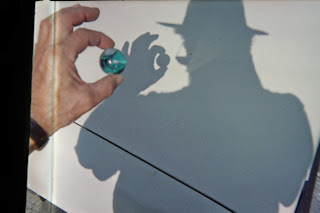Ron Gilker's Mokador Pub - Sutton rocks to his baton

By Manfried Helmuth Starhemberg
Sutton did not know what it was in for when Ron Gilker and his wife Ruth opened the restaurant Mocador. on November 6, 1979. Ron, a self styled "anarchist", a hippy in the best traditons of hippydom, car nut, computer specialist and world traveller happened upon this sleepy town. Slightly toned down,he is still there and his Pub Mocador has become a little slice of Las Vegas in a village mostly associated with the ski hill and the great stained glass windows of the Anglican church
.In 1837, long beforeSutton was recognized as a town, the place the Mocador now occupies, was called the "Tavern in the woods" and it has been in business as a taven, restaurant or pub ever since that time.
Ron Gilker is the product of his great grandfather's father's spirit. The man who ran New Carlisle in the Gaspe peninsula for about 30 years as a mayor modeled the kid. Ron spent most of his time having fun. Albeit, a graduate of Concordia University and higly trained computer specialist, Ron travelled the world, first in a 41 ft. sailing vessel for a year, when he did all the islands in the West Indies, then he roamed Europe and North Africa in his 1952 Merzedes Benz sedan which he abandoned in Paris (to his great regret to this day!)
In the late 70's, Ron went as far as Panama and roamed north America in a van and in exploring the world he finally found a place he wished to settle to: Sutton. With new wife Ruth, he purchased his present business and set out to father a family. Having known Ron for more than a decade, I can speak freely about this:Ruth and Ron divorced about 15 years ago, then reconciled. Ruth is just as much a part of the place as Ron is and they remind me of the Liz Taylor/Richard Burton saga: "You can't live with them but you can't live without them".

In Sutton today,every Wednesday and Friday we have live music at the Pub Mocador an amazingly, the neighbors in the village do not mind the noise. They bitch about the train whistles, which wake us up twice nighltly, but Ron Gilker's music which can be heard three blocks away, does not trouble any of the locals. A great friend of Ron's. John McGale is on this Friday night, he is well known for his work with"Offenbach" and has been a soloist at many shows and a friend of Ron's for two decades.
Every Friday the house is packed because it is the only place in Sutton where one may experience vibrant young talent mingle with tried professionals. On Wednesdays Ron often has an "open Mike" evening and local singers, musicians and solloists are allowed to showcase their work.
Mocador has seen many reiterations, first it was a 200 people restaurant, then in 2003 Ron left the kitchen and sublet the place to storied chef Christian Beuxlieux who left two years later to start his own Bistro next door but they are still best friends. New owners occupy the kitchen now but Ron and Ruth have kept the "pub" as their own and it is a vibrant and thriving business and a great place to go to in Sutton. It is also smack in the center of the village. "Location,Location", as the old joke goes - it works for Ron and his many friends.



















































